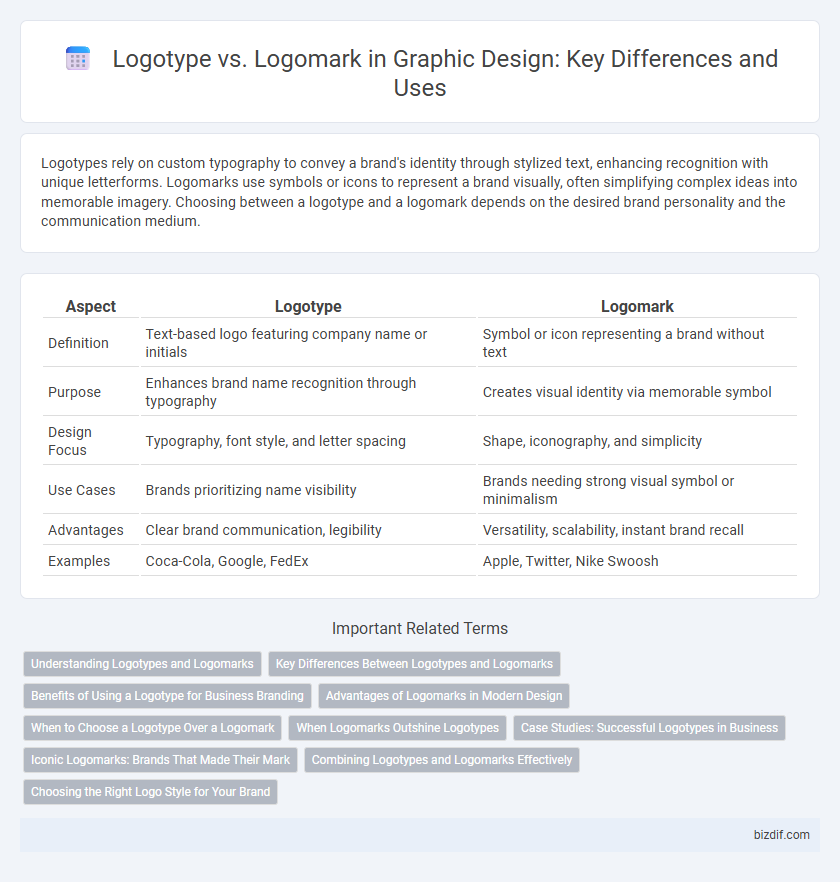Logotypes rely on custom typography to convey a brand's identity through stylized text, enhancing recognition with unique letterforms. Logomarks use symbols or icons to represent a brand visually, often simplifying complex ideas into memorable imagery. Choosing between a logotype and a logomark depends on the desired brand personality and the communication medium.
Table of Comparison
| Aspect | Logotype | Logomark |
|---|---|---|
| Definition | Text-based logo featuring company name or initials | Symbol or icon representing a brand without text |
| Purpose | Enhances brand name recognition through typography | Creates visual identity via memorable symbol |
| Design Focus | Typography, font style, and letter spacing | Shape, iconography, and simplicity |
| Use Cases | Brands prioritizing name visibility | Brands needing strong visual symbol or minimalism |
| Advantages | Clear brand communication, legibility | Versatility, scalability, instant brand recall |
| Examples | Coca-Cola, Google, FedEx | Apple, Twitter, Nike Swoosh |
Understanding Logotypes and Logomarks
Logotypes use custom typography to represent a brand name, emphasizing unique letterforms for instant recognition, while logomarks rely on symbolic icons or imagery without text to create visual identity. Understanding the distinction helps designers choose whether to highlight brand name clarity with logotypes or convey brand essence through abstract or illustrative logomarks. Effective branding often combines both elements, ensuring memorability and versatility across various media.
Key Differences Between Logotypes and Logomarks
Logotypes feature stylized typography that spells out a brand's name, emphasizing font choice and custom lettering to convey identity. Logomarks rely on symbols or icons without text, offering visual representation that enhances immediate brand recognition. The key difference lies in logotypes prioritizing text-based branding, while logomarks focus on image-based symbolism for versatile and memorable logos.
Benefits of Using a Logotype for Business Branding
Using a logotype in business branding enhances brand recognition by prominently featuring the company's name in a unique, customized font that reflects the brand's personality. It improves memorability and clarity, making it easier for customers to associate the brand with its visual identity. Logotypes also provide versatile application across digital and print media, ensuring consistent brand communication.
Advantages of Logomarks in Modern Design
Logomarks offer unparalleled visual simplicity and versatility, making them ideal for modern branding across diverse digital and physical platforms. Their abstract or symbolic nature enables immediate recognition and emotional connection without language barriers, enhancing global market appeal. Logomarks also scale efficiently, maintaining clarity and impact on everything from app icons to billboards, ensuring consistent brand identity.
When to Choose a Logotype Over a Logomark
Choosing a logotype over a logomark is ideal for brands seeking immediate name recognition and clarity, especially when the company name itself carries strong brand equity. Logotypes work best for startups or businesses with less visual association, as the stylized text can communicate the brand identity without ambiguity. This approach enhances memorability through custom typography and allows flexibility across digital and print media.
When Logomarks Outshine Logotypes
Logomarks outshine logotypes when brand recognition needs to transcend language barriers, relying on simple, memorable symbols instead of text. They excel in digital environments, offering versatility across various screen sizes and platforms while maintaining visual impact. In industries with global reach or quick visual engagement, logomarks deliver immediate brand identification and stronger emotional connections.
Case Studies: Successful Logotypes in Business
Successful logotypes in business, such as Coca-Cola and FedEx, demonstrate the power of distinctive typography that conveys brand identity clearly and memorably. Case studies reveal that logotypes, by focusing on custom letterforms, enhance brand recognition and versatility across digital and print platforms. These iconic wordmarks illustrate how strategic font choice and color can create emotional connections and reinforce brand loyalty.
Iconic Logomarks: Brands That Made Their Mark
Iconic logomarks like Apple's apple and Nike's swoosh exemplify powerful visual symbols that convey brand identity without relying on text. These singular, memorable icons enhance brand recognition worldwide and simplify communication across diverse languages and cultures. Effective logomarks distill complex brand values into minimalistic designs that resonate instantly with audiences.
Combining Logotypes and Logomarks Effectively
Combining logotypes and logomarks effectively enhances brand recognition by merging distinctive typography with memorable symbols. Strategic design balances visual harmony and clarity, ensuring the logo communicates the brand's identity across diverse platforms. Integrating color contrast and proportion maintains legibility and impact, optimizing both digital and print applications.
Choosing the Right Logo Style for Your Brand
Logotype and logomark serve distinct roles in brand identity, with logotypes using stylized text to emphasize a brand's name and logomarks relying on symbolic icons for instant recognition. Selecting the right logo style depends on factors such as brand personality, target audience, and industry context, where a logotype may suit brands seeking clarity and professionalism, while a logomark works well for visually-driven, memorable representation. Effective branding strategies often combine both elements to balance textual clarity and iconographic impact, ensuring cohesive visual communication.
Logotype vs Logomark Infographic

 bizdif.com
bizdif.com